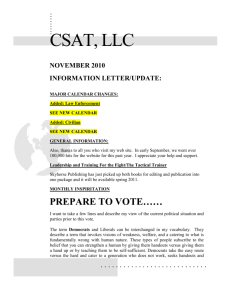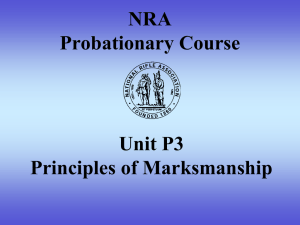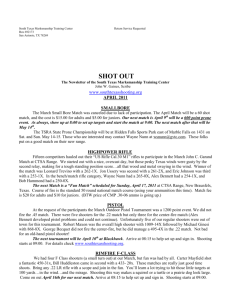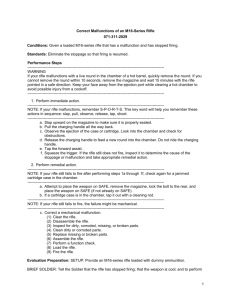American Rifle: A Biography, by Alexander Rose, ISBN: 0553-80517-7,
advertisement
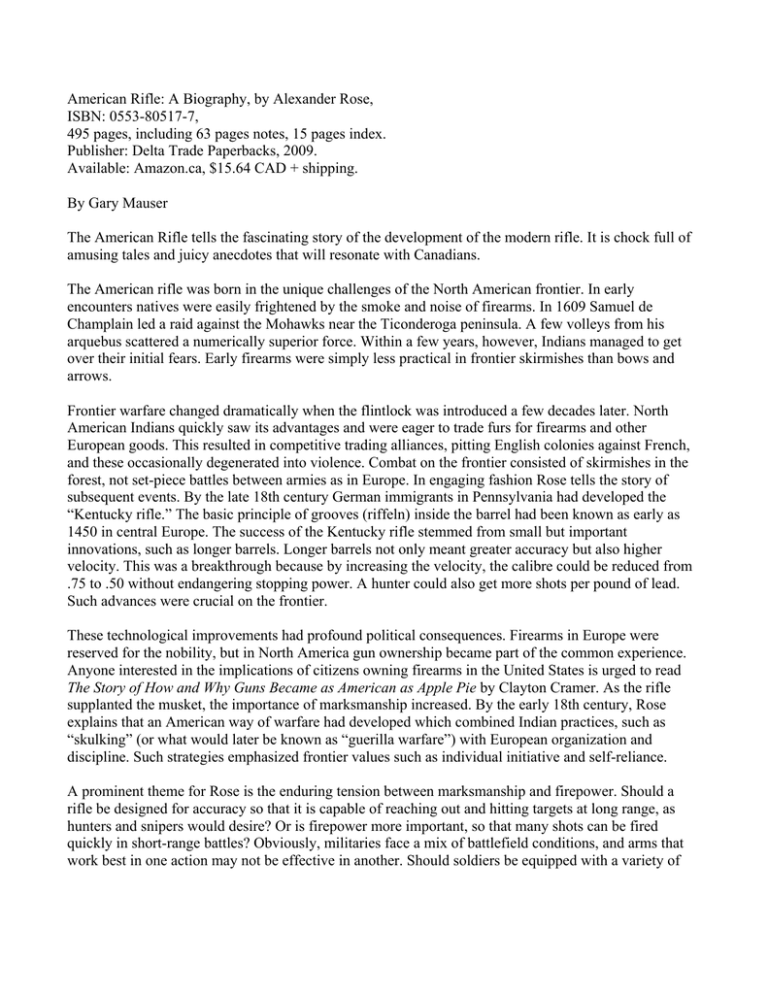
American Rifle: A Biography, by Alexander Rose, ISBN: 0553-80517-7, 495 pages, including 63 pages notes, 15 pages index. Publisher: Delta Trade Paperbacks, 2009. Available: Amazon.ca, $15.64 CAD + shipping. By Gary Mauser The American Rifle tells the fascinating story of the development of the modern rifle. It is chock full of amusing tales and juicy anecdotes that will resonate with Canadians. The American rifle was born in the unique challenges of the North American frontier. In early encounters natives were easily frightened by the smoke and noise of firearms. In 1609 Samuel de Champlain led a raid against the Mohawks near the Ticonderoga peninsula. A few volleys from his arquebus scattered a numerically superior force. Within a few years, however, Indians managed to get over their initial fears. Early firearms were simply less practical in frontier skirmishes than bows and arrows. Frontier warfare changed dramatically when the flintlock was introduced a few decades later. North American Indians quickly saw its advantages and were eager to trade furs for firearms and other European goods. This resulted in competitive trading alliances, pitting English colonies against French, and these occasionally degenerated into violence. Combat on the frontier consisted of skirmishes in the forest, not set-piece battles between armies as in Europe. In engaging fashion Rose tells the story of subsequent events. By the late 18th century German immigrants in Pennsylvania had developed the “Kentucky rifle.” The basic principle of grooves (riffeln) inside the barrel had been known as early as 1450 in central Europe. The success of the Kentucky rifle stemmed from small but important innovations, such as longer barrels. Longer barrels not only meant greater accuracy but also higher velocity. This was a breakthrough because by increasing the velocity, the calibre could be reduced from .75 to .50 without endangering stopping power. A hunter could also get more shots per pound of lead. Such advances were crucial on the frontier. These technological improvements had profound political consequences. Firearms in Europe were reserved for the nobility, but in North America gun ownership became part of the common experience. Anyone interested in the implications of citizens owning firearms in the United States is urged to read The Story of How and Why Guns Became as American as Apple Pie by Clayton Cramer. As the rifle supplanted the musket, the importance of marksmanship increased. By the early 18th century, Rose explains that an American way of warfare had developed which combined Indian practices, such as “skulking” (or what would later be known as “guerilla warfare”) with European organization and discipline. Such strategies emphasized frontier values such as individual initiative and self-reliance. A prominent theme for Rose is the enduring tension between marksmanship and firepower. Should a rifle be designed for accuracy so that it is capable of reaching out and hitting targets at long range, as hunters and snipers would desire? Or is firepower more important, so that many shots can be fired quickly in short-range battles? Obviously, militaries face a mix of battlefield conditions, and arms that work best in one action may not be effective in another. Should soldiers be equipped with a variety of tools (e.g., handgun, rifle, submachine gun, hand grenades and grenade launcher) or is it possible to design a rifle that could perform multiple tasks adequately? Back room political battles in Washington, DC have long determined military procurement. Rose brilliantly describes the frustrations facing innovators, such as John Hall, who attempted to convince the Ordnance Department in the early 1800s to replace slow and inaccurate muzzleloaders with his innovative breech-loading rifle. Hall’s rifles were more accurate than muskets, and, as breechloaders, they could be fired six times a minute, when the rate of fire for muskets was half that. Unfortunately, officials saw these very advantages as undermining traditional military discipline. They feared that soldiers armed with rapid-firing rifles would no longer be precisely controlled by their commanding officers. Bureaucrats in the Ordinance Department blocked Hall’s hard work and lonely experimentation at every turn for more than thirty years until he died. Despite the obvious potential of breechloaders, officials preferred traditional muzzle-loading muskets. Hall would not be the last innovator to be stymied by the Byzantine politics of the bureaucracy. In the 1850s the breechloader faced a rival technological innovation, the Minié bullet. Its improved shape meant that rifles could be loaded from the muzzle almost as rapidly as muskets, giving rise to the rifle musket. The bureaucrats had discovered another reason for rejecting the breechloader. During the Civil War in the 1860s, not even President Abraham Lincoln could prevail over the bureaucracy’s choice of the rifle-musket. Any officers wishing to use a breech-loading Sharps had to purchase their own. The latter half of the 19th Century saw the Americans fall behind the Europeans in rifle development. Much of this was due to the sclerotic policies in the Ordnance Department. In 1993, the Americans finally adopted their first service weapon using smokeless powder, the .30 calibre Krag, which replaced the .45-70 single-shot Springfield. Meanwhile in Europe, Ferdinand von Mannlicher and Peter-Paul Mauser were competing with the French Lebel for dominance. The English were the beneficiaries of perhaps the most egregious example of American blundering. In 1881, James Paris Lee, a Scottish Canadian, managed to get the US Ordnance Department to test his design, the first detachable-box magazine-fed rifle. Despite the endorsement of General Sherman, the bureaucracy rejected Lee’s innovative rifle with its five-shot magazine. Britain’s Small Arms Committee adopted the Lee in 1887 as the service rifle of the Empire. Subsequent modifications resulted in the Lee Enfield and the .303 British cartridge, which proved to be one of the most successful rifle-and-cartridge combinations of the 20th century. For more information about the Lee Enfield, see Skennerton’s excellent book. Rose describes the way Teddy Roosevelt’s commitment to marksmanship was behind the adoption of the Springfield Model 1903 and the .30-06 cartridge. While with the Rough Riders in Cuba during the Spanish American war, Roosevelt had been impressed by the 1893 Spanish Mauser and its 7x57mm round which had a higher velocity than the US Army’s .30 Krag. Roosevelt decided that the Krag should be replaced with a rifle that combined “rapidity with accuracy.” The result was the M1903 that borrowed heavily from the Mauser rifle. One of the features of the M1903 was the "charger loading" system, which was a magazine loaded from five-round stripper clips. The original .30 cartridge for the M1903 did not live up to expectations, so in 1906 the government lengthened the case and adopted a Spitzer bullet to create the famous .30-06 round. This round saw use in both World Wars, Korea and Vietnam, and is still highly prized by marksmen becoming the all-time favourite hunting round in the US. How many readers would know that the US paid almost a million dollars to German firearms manufactures for violating their patents on both the M1903 and the .30-06? After World War II, the National Rifle Association’s commitment to civilian marksmanship played an important role in the adoption of the M14 as the American rifle. Rose recounts the bitter battles that determined NATO’s choice of the T65 cartridge (7.62x51mm NATO) over the .280 British. NATO would agree upon a common cartridge in 1957, but split over which rifle to use. Europeans and the British Commonwealth preferred the FN-FAL to the M14. The M14 almost immediately ran into problems in Vietnam. It was too unwieldy for jungle fighting yet too light to easily control in fully-automatic fire. Rose explains how concerns with firepower dominated marksmanship in the search for a replacement. Even before the M14 had been adopted, support was gathering for a smaller cartridge which meant a smaller rifle. Infantrymen could easily carry much more ammunition. ArmaLite soon developed the AR-15 shooting a variant of the Remington .222 that could propel a .22-calibre bullet at 3,250 feet per second. When the AR-15 was field tested in South Vietnam by the Special Forces, they were enthusiastic about its effectiveness on the battlefield partly because the rifle’s light and fast round inflicted devastating wounds. The barrel’s rate of twist in its rifling destabilized the bullet, which caused it to tumble and wobble once inside a target, producing a surprisingly massive wound cavity. Rose only touches lightly on the question of “internal ballistics.” For more information about how bullet characteristics influence the severity of wounding, the reader could consult Hatcher’s Notebook. In the 1960s, firepower again trumped marksmanship despite the NRA’s objections. Secretary of Defense McNamara ordered the adoption of the M16 in 1964 using the 5.56x45mm NATO cartridge. Unfortunately, the hurried introduction of the M16 created its own difficulties in Vietnam. Fouling problems caused the M16 to jam resulting in needless deaths on the battlefield. But these were soon corrected, with design changes and better training in cleaning the weapon, and the M16 became one of the most successful battle rifles in American history. In the concluding chapter, Rose relates the current difficulties facing the Pentagon in replacing the M16. The choice between the M4, SCAR and HK416 depends upon experiences in Iraq and Afghanistan as much as battles among suppliers such as Colt, FN Herstal, and H&K. Rose concludes by saying American success on the battlefield continues to rely upon skilled riflemen. Rose’s focus on American military rifles ignores some historically important firearms. Perhaps the most important of these are the semi-automatic (i.e., self-loading) handguns and fully automatic weapons invented by John Moses Browning. The Browning legacy is described well in John M. Browning, American Gunmaker. Although mentioned briefly, Rose gives only passing consideration to European rifle developments. Readers interested in learning more about Mauser rifles should consult John Walter’s book, The German Rifle. Rose’s description of the tension between marksmanship and firepower goes far in illuminating the controversy surrounding Canada’s Ross rifle during World War I. The Ross Rifle Story does a superb job in relating the problems and politics that plagued Canada’s innovative rifle. In sum, I enjoyed reading this book. It is engagingly written and does not lose the reader in technical trivia. The stories of the labyrinthine bureaucratic politics behind historic battles rings true for anyone attempting to understand current decision-making in Ottawa. The author’s website includes an expanded bibliography for those interested in digging deeper into the fascinating story of American rifle development. Here are my suggested books for further exploration: Browning, John and Curt Gentry (1964) John M. Browning, American Gunmaker. Browning. Cramer, Clayton E. Armed America. (2006) The Story of How and Why Guns Became as American as Apple Pie. Nelson. Nashville, Tennessee. Hatcher, Julian S. (1947). Hatcher's Notebook, Harrisburg, Pa., Military Service Pub. Co. Phillips, R, F. Dupuis, and J. Chadwick. (1984) The Ross Rifle Story. Published by John Chadwick; available through The Halifax Museum, Halifax, NS Skennerton Ian. (1993) The Lee-Enfield Story. IDSA Books. Piqua, Ohio. Walter, John (1979). The German Rifle. Arms and Armour Press, London, England.
